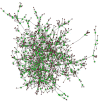Hepatitis C virus treatment as prevention in an extended network of people who inject drugs in the USA: a modelling study
- PMID: 29153265
- PMCID: PMC5860640
- DOI: 10.1016/S1473-3099(17)30676-X
Hepatitis C virus treatment as prevention in an extended network of people who inject drugs in the USA: a modelling study
Abstract
Background: Chronic infections with hepatitis C virus (HCV) and HIV are highly prevalent in the USA and concentrated in people who inject drugs. Treatment as prevention with highly effective new direct-acting antivirals is a prospective HCV elimination strategy. We used network-based modelling to analyse the effect of this strategy in HCV-infected people who inject drugs in a US city.
Methods: Five graph models were fit using data from 1574 people who inject drugs in Hartford, CT, USA. We used a degree-corrected stochastic block model, based on goodness-of-fit, to model networks of injection drug users. We simulated transmission of HCV and HIV through this network with varying levels of HCV treatment coverage (0%, 3%, 6%, 12%, or 24%) and varying baseline HCV prevalence in people who inject drugs (30%, 60%, 75%, or 85%). We compared the effectiveness of seven treatment-as-prevention strategies on reducing HCV prevalence over 10 years and 20 years versus no treatment. The strategies consisted of treatment assigned to either a randomly chosen individual who injects drugs or to an individual with the highest number of injection partners. Additional strategies explored the effects of treating either none, half, or all of the injection partners of the selected individual, as well as a strategy based on respondent-driven recruitment into treatment.
Findings: Our model estimates show that at the highest baseline HCV prevalence in people who inject drugs (85%), expansion of treatment coverage does not substantially reduce HCV prevalence for any treatment-as-prevention strategy. However, when baseline HCV prevalence is 60% or lower, treating more than 120 (12%) individuals per 1000 people who inject drugs per year would probably eliminate HCV within 10 years. On average, assigning treatment randomly to individuals who inject drugs is better than targeting individuals with the most injection partners. Treatment-as-prevention strategies that treat additional network members are among the best performing strategies and can enhance less effective strategies that target the degree (ie, the highest number of injection partners) within the network.
Interpretation: Successful HCV treatment as prevention should incorporate the baseline HCV prevalence and will achieve the greatest benefit when coverage is sufficiently expanded.
Funding: National Institute on Drug Abuse.
Copyright © 2018 Elsevier Ltd. All rights reserved.
Figures




Comment in
-
How to eliminate HCV in people who inject drugs in the USA.Lancet Infect Dis. 2018 Feb;18(2):134-135. doi: 10.1016/S1473-3099(17)30678-3. Epub 2017 Nov 15. Lancet Infect Dis. 2018. PMID: 29153267 Free PMC article. No abstract available.
-
Hepatitis C virus treatment as prevention in people who inject drugs.Lancet Infect Dis. 2018 Apr;18(4):379. doi: 10.1016/S1473-3099(18)30130-0. Epub 2018 Mar 21. Lancet Infect Dis. 2018. PMID: 29582763 No abstract available.
Similar articles
-
The hepatitis C virus epidemics in key populations (including people who inject drugs, prisoners and MSM): the use of direct-acting antivirals as treatment for prevention.Curr Opin HIV AIDS. 2015 Sep;10(5):374-80. doi: 10.1097/COH.0000000000000179. Curr Opin HIV AIDS. 2015. PMID: 26248124 Free PMC article. Review.
-
Role of direct and indirect social and spatial ties in the diffusion of HIV and HCV among people who inject drugs: a cross-sectional community-based network analysis in New Delhi, India.Elife. 2021 Aug 3;10:e69174. doi: 10.7554/eLife.69174. Elife. 2021. PMID: 34342266 Free PMC article.
-
Modeling Combination Hepatitis C Virus Treatment and Prevention Strategies in a Network of People Who Inject Drugs in the United States.Clin Infect Dis. 2021 Mar 1;72(5):755-763. doi: 10.1093/cid/ciaa142. Clin Infect Dis. 2021. PMID: 32060534 Free PMC article.
-
Respondent-driven sampling for identification of HIV- and HCV-infected people who inject drugs and men who have sex with men in India: A cross-sectional, community-based analysis.PLoS Med. 2017 Nov 28;14(11):e1002460. doi: 10.1371/journal.pmed.1002460. eCollection 2017 Nov. PLoS Med. 2017. PMID: 29182638 Free PMC article.
-
Hepatitis C virus treatment as prevention in people who inject drugs: testing the evidence.Curr Opin Infect Dis. 2015 Dec;28(6):576-82. doi: 10.1097/QCO.0000000000000216. Curr Opin Infect Dis. 2015. PMID: 26524330 Free PMC article. Review.
Cited by
-
Integrated hepatitis C treatment is associated with improved retention and success in outpatient treatment for opioid use disorder at a private clinic.Front Psychiatry. 2022 Sep 14;13:932306. doi: 10.3389/fpsyt.2022.932306. eCollection 2022. Front Psychiatry. 2022. PMID: 36186876 Free PMC article.
-
Sexually Transmitted Infection (STI) Incidence, STI Screening, and Human Immunodeficiency Virus Preexposure Prophylaxis Uptake in United States Veterans With Opioid Use Disorder in Long Island, New York.Open Forum Infect Dis. 2024 Jul 22;11(8):ofae429. doi: 10.1093/ofid/ofae429. eCollection 2024 Aug. Open Forum Infect Dis. 2024. PMID: 39086462 Free PMC article.
-
Barriers to hepatitis C direct-acting antiviral therapy among HIV/hepatitis C virus-coinfected persons.J Gastroenterol Hepatol. 2021 Apr;36(4):1095-1102. doi: 10.1111/jgh.15228. Epub 2020 Sep 8. J Gastroenterol Hepatol. 2021. PMID: 32840904 Free PMC article.
-
Development and Validation of an Electronic Medical Record-Based Algorithm to Identify Patient Milestones in the Hepatitis C Virus Care Cascade.Open Forum Infect Dis. 2018 Jul 3;5(7):ofy153. doi: 10.1093/ofid/ofy153. eCollection 2018 Jul. Open Forum Infect Dis. 2018. PMID: 30046641 Free PMC article.
-
Treatment of Hepatitis C virus among people who inject drugs at a syringe service program during the COVID-19 response: The potential role of telehealth, medications for opioid use disorder and minimal demands on patients.Int J Drug Policy. 2022 Mar;101:103570. doi: 10.1016/j.drugpo.2021.103570. Epub 2021 Dec 20. Int J Drug Policy. 2022. PMID: 34954493 Free PMC article.
References
-
- Shepard C, Finelli L, Alter M. Global epidemiology of hepatitis C virus infection. Lancet ID. 2005;5(9):558–67. - PubMed
-
- The Polaris Observatory HCV Collaborators. Global prevalence and genotype distribution of hepatitis C virus infection in 2015: a modelling study. Lancet Gastroenterol Hepatol. 2017;2(3):161–76. - PubMed
-
- Strader DB. Coinfection with HIV and hepatitis C virus in injection drug users and minority populations. Clin Infect Dis. 2005;41(Suppl 1):S7–13. - PubMed
Publication types
MeSH terms
Substances
Grants and funding
LinkOut - more resources
Full Text Sources
Other Literature Sources
Medical

